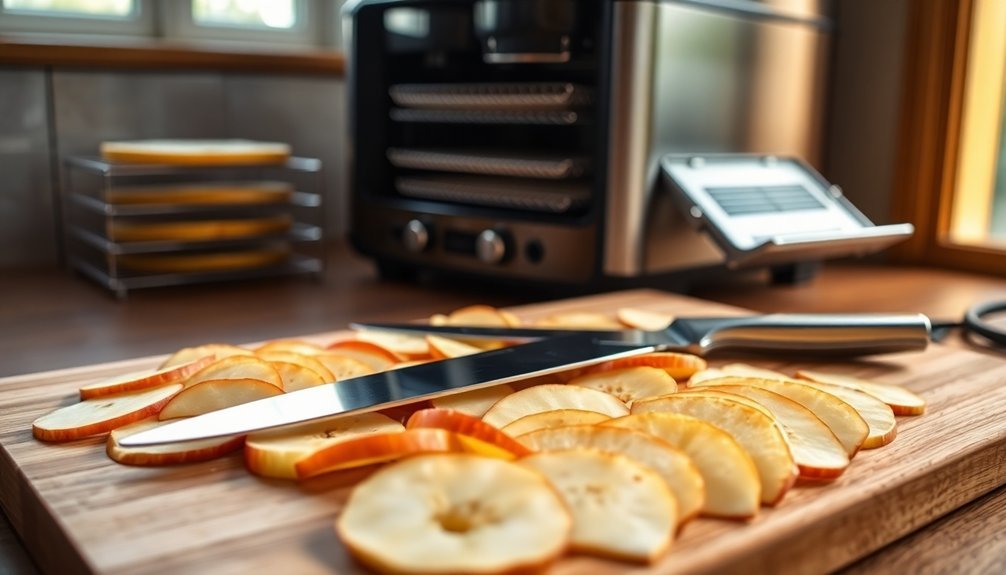Mastering food dehydration starts with precise slicing – use a mandoline or sharp knife to create uniform, thin pieces that'll dry evenly and pack efficiently. You'll need to maintain proper temperatures throughout the process, with different foods requiring specific heat levels (like herbs at 95°F and meats at 165°F). For storage, opt for vacuum-sealed or Mylar bags with oxygen absorbers, and don't forget to include clear rehydration instructions on your labels. Pack meals in bags suitable for direct hot water pouring on the trail. These fundamentals just scratch the surface of creating perfect lightweight meals for your next adventure.
Proper Food Slicing Methods

Whether you're planning a weekend trek or a long-distance hike, proper food slicing methods are critical for successful dehydration. You'll need to start by selecting the right tools, such as a mandoline slicer or a sharp knife, to achieve consistent, precise cuts that will dry evenly.
When preparing your ingredients, slice them thinly and uniformly, making sure you've chosen mature fruits for better flavor. If you're working with vegetables that typically require cooking, steam them before slicing to guarantee even dehydration. Consider that individual drying of components yields better results.
For raw meat, cut it into bite-sized pieces at home to minimize cleanup in the backcountry, and always sanitize your surfaces and utensils thoroughly after handling.
As you arrange your sliced foods on the dehydrator trays, avoid overlapping pieces to allow proper airflow. Line your trays with parchment paper or silicone mats to prevent sticking, especially when working with wet ingredients.
Remember that different foods require different slicing thicknesses – fruits can be cut slightly thicker than vegetables. As the food dries, break up any clumps that form to maintain even drying throughout the process.
Temperature Control Mastery
Mastering temperature control stands at the heart of successful food dehydration. Different foods require specific temperatures to dry properly, with herbs needing just 95°F while poultry demands 165°F. You'll need to monitor these temperatures carefully to prevent bacterial growth and guarantee proper preservation of your trail meals. The process works by using low heat and airflow to remove moisture from foods through controlled evaporation.
To avoid case hardening, which can trap moisture inside your food and lead to spoilage, you'll want to:
- Keep temperatures consistent throughout the drying process
- Cut your food into uniform, thin pieces
- Check progress by slicing samples in half
- Rotate trays every few hours for even drying
When using your dehydrator or oven, maintain proper airflow by avoiding overcrowded trays. If you're using an oven, crack the door slightly to release excess moisture. Always use a thermometer to verify temperatures, as guesswork can lead to under-dried food that won't last on the trail.
Remember that drying times vary greatly based on food type and thickness. While herbs might dry quickly at lower temperatures, dense foods like meat and poultry require longer exposure to higher heat to guarantee safe preservation.
Smart Storage Solutions

Proper storage makes or breaks your dehydrated food's longevity on the trail. You'll need to choose the right containers and storage methods to protect your trail meals from moisture, light, and pests. While Ziploc freezer bags work for short trips, invest in vacuum-sealed or Mylar bags with oxygen absorbers for extended adventures. Vacuum sealing ensures optimal preservation of your dehydrated foods during long-term storage.
| Storage Type | Best For | Shelf Life |
|---|---|---|
| Vacuum Sealed | Multi-week trips | 6-12 months |
| Mylar + O2 Absorber | Long-term storage | 1-5 years |
| Freezer Bags | Weekend trips | 1-3 months |
Store your dehydrated meals in a cool, dark place and consider using a 5-gallon bucket for additional protection against rodents. Don't forget to add desiccant packs or oxygen absorbers to control moisture, and always let food cool completely before packaging to prevent condensation. Label everything with the contents, date, and rehydration instructions.
For maximum convenience on the trail, package meals in bags that you can pour hot water directly into. Include a 200cc oxygen absorber if you're using Mylar bags, and consider using a cozy to maintain temperature while your food rehydrates.
Frequently Asked Questions
Can I Dehydrate Pre-Cooked Meals and Maintain Their Nutritional Value?
Yes, you can preserve most nutrients when you dehydrate pre-cooked meals. By using low temperatures (105-160°F), rotating trays regularly, and storing properly in airtight containers, you'll maintain significant nutritional value.
How Long Can Properly Dehydrated and Stored Food Remain Safe to Eat?
You'll find home-dehydrated food lasts up to a year with proper storage, while commercial options vary greatly – from 2 to 30 years. Keep your food in cool, dark places using airtight containers for best results.
Which Foods Should Never Be Dehydrated Due to Safety Concerns?
You shouldn't dehydrate eggs, dairy products, fatty meats like bacon, or oily foods. These items can harbor dangerous bacteria, turn rancid, or develop mold growth, making them unsafe for consumption.
Does Altitude Affect Dehydration Time and Temperature Requirements While Hiking?
While altitude won't directly affect your dehydration time, you'll find low humidity at high altitudes can speed up drying. You'll still need to maintain standard temperatures between 95-160°F for proper food dehydration.
Can I Mix Different Dehydrated Ingredients Before Storage for Ready-Made Meals?
You shouldn't mix dehydrated ingredients before storage, as they can transfer moisture between them. Instead, store ingredients separately and combine them just before your trip to maintain their quality and prevent spoilage.
In Summary
You'll find dehydrating your own trail food rewarding once you've mastered these fundamentals. With proper slicing techniques, careful temperature monitoring, and effective storage methods, you're ready to create lightweight, nutritious meals for your next backcountry adventure. Don't forget to test your dehydrated creations at home before hitting the trail. Now that you're equipped with these essential tips, you can start experimenting with your own trail-worthy recipes.





Leave a Reply